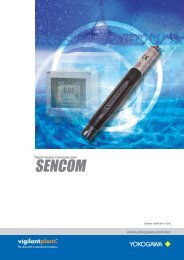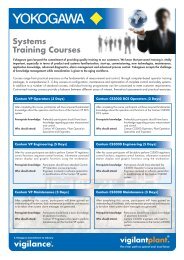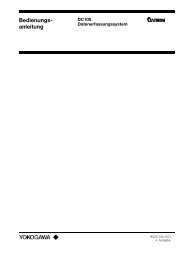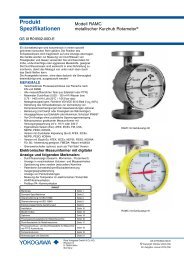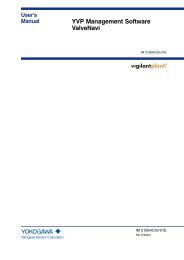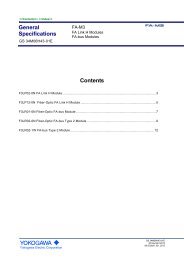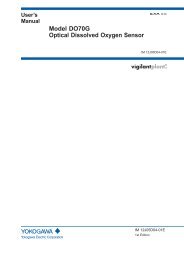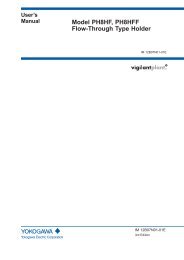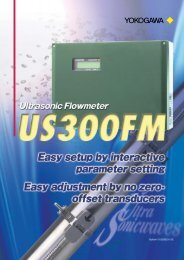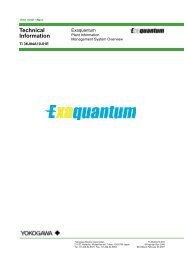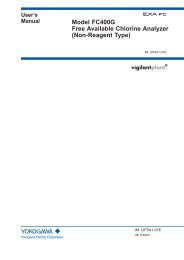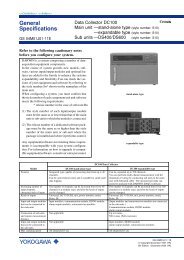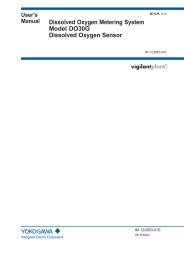User's Manual for CM6G - Yokogawa
User's Manual for CM6G - Yokogawa
User's Manual for CM6G - Yokogawa
Create successful ePaper yourself
Turn your PDF publications into a flip-book with our unique Google optimized e-Paper software.
11-311.3 Differential Pressure Transmitter Section1) Check the orifice section of the orifice assembly.→When the orifice plate is contaminated, clean it as according to the paragraph 10.2.1.2) Check any leakage in the pressure transmission pipe of each differential pressure transmitter.3) Check the temperature (thermistor resistance value) setting of orifice assembly.→If the resistance value is not 3.6 to 4.2 kΩ, the temperature controller may have a failure.11.4 Signal SectionMeasure the output of each components by using digital voltmeter.1) Set the “METER” switch on the front panel of the calorie detector to “P.MEAS” and measure X5of the computing station. If preheating is not required, the appropriate output is approximately0 to 20 mV, which is nearly proportional to 0 to (WI value, namely the highest value in themeasurement range). If preheating is required, the appropriate output is approximately 4 to 20mV, which is nearly proportional to 0 to (WI value, namely the highest value in the measurementrange).For example:When the WI value of the highest level in the measuring range is 100 WI, if the sample gas is80 WI, the output voltage is about 16 mV (when no preheating circuit).In spite of both the gas pressure control section and the differential pressure being normal, theoutput is widely different, it is likely to be some blockade in the air flow distribution line of theburner unit. If such case happens, check the burner flame as mentioned in paragraph 10.3.1.→If the output has very weak power in spite of the burner being well burning, it is likely thewire disconnection in the thermocouple happens.2) Measure 3 (+) and 4 (-) on the terminal board of the calorie detector, which normal output, whenpreheating circuit does not exist, is 1 to 5 V almost in proportion to 0 to (WI value, namely thehighest value in the measurement range). If preheating circuit exist, approx. 1.8 to 5 V is almostin proportion to 0 to (WI value, namely the highest value in the measurement range).3) Measure 17 (+) and 18 (-) on the terminal block of the calorie detector. The appropriate value is23 V ±1%.→If difficult to obtain the normal value, it is due to the defect of the distributor in the caloriedetector.4) Measure 15 (+) and 16 (-) on the terminal block of the calorie detector. The appropriate value is23 V ±1%.→If difficult to obtain the normal value, it is due to the defect of the distributor in the caloriedetector.5) Measure 8 (+) and 7 (-) on the terminal block of the calorie detector. The appropriate value is 3 V± 0.2 V.→If the measured value varied very much in spite of the air pressure control section beingnormal, it is likely the differential pressure transmitter considered to be defective.6) Measure 6 (+) and 7 (-) on the terminal block of the calorie detector. The appropriate value is 3 V± 0.2 V.→ If the measurement value is greater than the appropriate value, even though the gaspressure controller is normal, the differential pressure transmitter considered to bedefective.IM 11R02A01-02E



